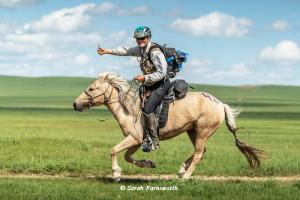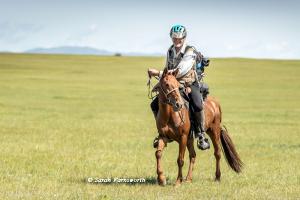By Liz Ampairee, the Adventurists
In an extraordinary, seven-day demonstration of horsemanship, fortitude, and navigational skill, the USA’s Robert (Bob) Long, 70, became the oldest winner of the 1,000km Mongol Derby, the world’s longest horse race, on August 14, 2019.
In doing so he battled the weather gods, who threw everything they had at our brave crazy riders, from torrential rain to burning sun and then freezing temperatures, and harsh terrain. All on the back of semi-wild, tough-as-teak Mongolian horses, who like to start the day by bucking their riders off just to show who’s boss.
Cowboy Bob, who is from Cheyenne, Wyoming but now lives in Boise, Idaho, completed the 1,000km race by changing horses 28 times. At each horse station the small, tough, semi-wild Mongolian horses are carefully checked over by vets, and all Bob’s horses vetted cleanly throughout the race, meaning he received no veterinary time-penalties. Plenty of the 2019 riders received medical treatment for “minor” injuries, such as a broken nose, concussion and dehydration, but not Bob, whose solo adventure across the steppe has been one of the most impressive performances seen in the history of the Derby.
Bob’s life has been built around horses. He trained and sold broncs to fund his university education, rode and trained mules for packing and hunting, and worked with young Appaloosas and Quarter Horses. He is a master at the competitive sport of Extreme Mountain Trail, and has many awards in that discipline; it’s the ideal preparation for the most extreme race of all, the Mongol Derby. He also pursues Ranch Horse Versatility - Ranch Cow Cutting, Ranch Reining, Ranch Riding, Ranch Trail, and Ranch Working Cow. These are Multiple disciplines that require a multitude of skill sets to be successful. He and his girlfriend Stephanie Long currently share two Quarter Horse geldings, and in the winter he spends time on his Arctic Cat sled with his daughter, Briana Long Gordon.
He has a PhD in Public Health, and in 2013 retired from Healthwise, a company he helped build up from the ground.
“It’s nothing – you just ride 650 miles. There’s nothing to it,” joked Bob. “I’ve only stayed overnight at one horse station; I’ve been staying with local families. They’re spectacular.”
Asked how it felt to be the oldest winner of the Derby, he replied dismissively: “Age is just a number.”
Mr. Tom, head honcho of race organizers The Adventurists, said: “Bob isn’t just the oldest; he has ridden better and stronger, camping out more, than anyone else. We opened up the course this year to make navigation a key skill again, and Bob absolutely nailed it. The man is tougher than a box of concrete.”
Local herders came from miles around to greet Bob. The horse is an integral part of Mongolian culture, and they recognized another truly instinctive horseman in Bob. He rode carrying a picture of himself as a child on a horse that was taken by his mother, who died recently.
South Africa’s Wiesman Nel was a very worthy second place, and a group consisting of Margreet Voermans (The Netherlands) and three Aussies – Jesse Byrne, Justine Hales and Sarah Brown – crossed the line in joint-third place. They were closely followed by Texan Frank Winters and Australia’s Sam Chisholm, and then Hungary’s Zsofia Homor.
The focus in the last days of the race has been on Bob Long, a modest but inwardly confident man who, when he applied to ride in the Derby, said: “I am riding to accept the challenge of selecting and managing a good horse across a historical, storied, and difficult landscape. To interact with the legendary and best horsemen of all time. To test my skill, my nerve, and my mental fortitude.” Challenge met, Bob!
About this year’s Mongol Derby:
August 4-6: Pre-race training
August 7: Start of the 2019 Mongol Derby
August 16: Final riders expected to finish
The race recreates Chinggis (Genghis) Khaan’s (1162-1227) ancient horse messenger system in epic fashion. Khan was the founder and first Great Khan of the Mongol Empire, which became the largest contiguous empire in history. He came to power by uniting many of the nomadic tribes of Northeast Asia.
The hardy and semi-wild native horses of Mongolia reprise their traditional role as the legs and lungs of the adventure and the horse stations, or morin urtuus, are manned by nomadic herding families as they traditionally were. The messengers themselves are played by horsemen and adventurers from around the world, all riding up to 160kms a day, navigating independently, and changing horses at 40 kilometer intervals.
Photo credit: Sarah Farnsworth/Mongol Derby
See more photos of the Mongol Derby by Sarah Farnsworth here: https://www.flickr.com/photos/mongolderby/
In an extraordinary, seven-day demonstration of horsemanship, fortitude, and navigational skill, the USA’s Robert (Bob) Long, 70, became the oldest winner of the 1,000km Mongol Derby, the world’s longest horse race, on August 14, 2019.
In doing so he battled the weather gods, who threw everything they had at our brave crazy riders, from torrential rain to burning sun and then freezing temperatures, and harsh terrain. All on the back of semi-wild, tough-as-teak Mongolian horses, who like to start the day by bucking their riders off just to show who’s boss.
Cowboy Bob, who is from Cheyenne, Wyoming but now lives in Boise, Idaho, completed the 1,000km race by changing horses 28 times. At each horse station the small, tough, semi-wild Mongolian horses are carefully checked over by vets, and all Bob’s horses vetted cleanly throughout the race, meaning he received no veterinary time-penalties. Plenty of the 2019 riders received medical treatment for “minor” injuries, such as a broken nose, concussion and dehydration, but not Bob, whose solo adventure across the steppe has been one of the most impressive performances seen in the history of the Derby.
Bob’s life has been built around horses. He trained and sold broncs to fund his university education, rode and trained mules for packing and hunting, and worked with young Appaloosas and Quarter Horses. He is a master at the competitive sport of Extreme Mountain Trail, and has many awards in that discipline; it’s the ideal preparation for the most extreme race of all, the Mongol Derby. He also pursues Ranch Horse Versatility - Ranch Cow Cutting, Ranch Reining, Ranch Riding, Ranch Trail, and Ranch Working Cow. These are Multiple disciplines that require a multitude of skill sets to be successful. He and his girlfriend Stephanie Long currently share two Quarter Horse geldings, and in the winter he spends time on his Arctic Cat sled with his daughter, Briana Long Gordon.
He has a PhD in Public Health, and in 2013 retired from Healthwise, a company he helped build up from the ground.
“It’s nothing – you just ride 650 miles. There’s nothing to it,” joked Bob. “I’ve only stayed overnight at one horse station; I’ve been staying with local families. They’re spectacular.”
Asked how it felt to be the oldest winner of the Derby, he replied dismissively: “Age is just a number.”
Mr. Tom, head honcho of race organizers The Adventurists, said: “Bob isn’t just the oldest; he has ridden better and stronger, camping out more, than anyone else. We opened up the course this year to make navigation a key skill again, and Bob absolutely nailed it. The man is tougher than a box of concrete.”
Local herders came from miles around to greet Bob. The horse is an integral part of Mongolian culture, and they recognized another truly instinctive horseman in Bob. He rode carrying a picture of himself as a child on a horse that was taken by his mother, who died recently.
South Africa’s Wiesman Nel was a very worthy second place, and a group consisting of Margreet Voermans (The Netherlands) and three Aussies – Jesse Byrne, Justine Hales and Sarah Brown – crossed the line in joint-third place. They were closely followed by Texan Frank Winters and Australia’s Sam Chisholm, and then Hungary’s Zsofia Homor.
The focus in the last days of the race has been on Bob Long, a modest but inwardly confident man who, when he applied to ride in the Derby, said: “I am riding to accept the challenge of selecting and managing a good horse across a historical, storied, and difficult landscape. To interact with the legendary and best horsemen of all time. To test my skill, my nerve, and my mental fortitude.” Challenge met, Bob!
About this year’s Mongol Derby:
August 4-6: Pre-race training
August 7: Start of the 2019 Mongol Derby
August 16: Final riders expected to finish
The race recreates Chinggis (Genghis) Khaan’s (1162-1227) ancient horse messenger system in epic fashion. Khan was the founder and first Great Khan of the Mongol Empire, which became the largest contiguous empire in history. He came to power by uniting many of the nomadic tribes of Northeast Asia.
The hardy and semi-wild native horses of Mongolia reprise their traditional role as the legs and lungs of the adventure and the horse stations, or morin urtuus, are manned by nomadic herding families as they traditionally were. The messengers themselves are played by horsemen and adventurers from around the world, all riding up to 160kms a day, navigating independently, and changing horses at 40 kilometer intervals.
Photo credit: Sarah Farnsworth/Mongol Derby
See more photos of the Mongol Derby by Sarah Farnsworth here: https://www.flickr.com/photos/mongolderby/















